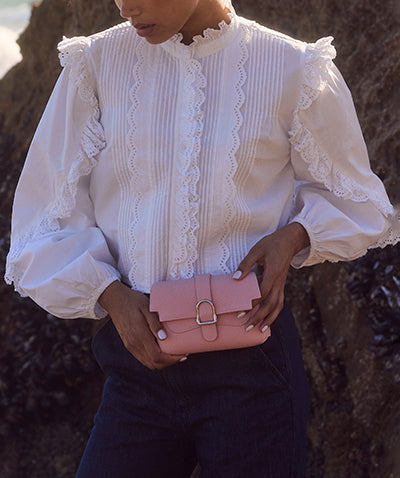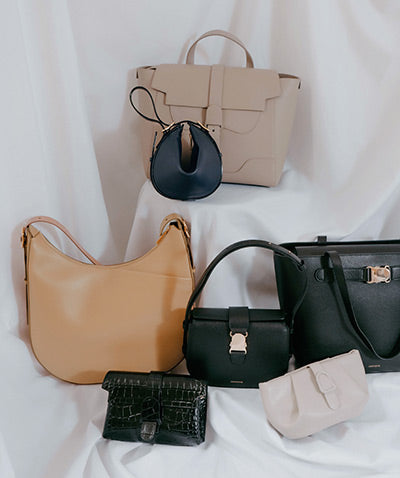Gift Note Edit
${ cartNote }
${ GWbtnTxt() }
Add offer code at checkout.
Shipping
Free
Subtotal
${ formatMoney(cart.total_price) }
Due Today
$0


See details.
Genuine Leather: What Makes It Genuine?
The term “genuine leather” has become extremely popular in the leather industry. But what does it actually mean? In order to understand the exact quality of the leather product you are purchasing, it's important to understand all of the terminologies in the industry.
If you are in the market for a new leather good, read on to learn more about different leather grades and what to look for in order to get the highest quality product.
Defining the Leather Grades
At a high level, there are 5 different terms for leather and leather grades:
- Full grain leather
- Top grain leather
- Split grain leather
- Genuine leather
- Bonded leather
Genuine and bonded leather are not actually a traditional “grade” of leather. However, these terms have become popular in the industry and are more readily known by the consumer. To really understand what you are paying for, we will walk through the leather making process to further describe how each grade is used and what it means for the quality of the final product.
First, in order for a material to be considered leather, it must come from the hide of an animal and will always go through a process of treatment and tanning. The layers of the hide as well as the tanning process further differentiate leather products from one another.
However, before any tanning or treatment takes place, the first step in creating leather is to split the hide. Hide splitting is what produces the 5 different leather grades noted above.
The hide of the cow is usually somewhere between 6mm and 10mm thick. It’s impossible to make leather goods from this alone, hence the need to start by splitting the hide.
1. Full Grain Leather
This is a cut of the hide that has the full and complete grain still intact. This is the only type of leather that keeps the entire full grain intact, hence its name. None of the remaining leather will have this level of grain present.
Full grain leather is the highest quality, the most durable, and the most resistant to wear. Because of this, full grain leather is used in the making of Italian leather, which is the best leather on the market, hence why SENREVE only uses 100% Italian leather in our handbags (save for our new 100% Vegan Collection, of course).

When it comes to products made from the full grain, they are usually so durable that they will last several lifetimes. For this reason, full grain leather products can be repaired if there are any stitching issues, or even reused, making it a more sustainable option in the long run.
2. Top Grain Leather
“Top grain” is a misused term in the leather industry. There is a very wide variety of leather types that can fall under the umbrella of top grain. Some products that are of lower quality claim to be top grain but are not actually even made from the top cut of the cowhide. Because of this, the best way to understand top grain is to compare it to the full grain counterpart.
Full Grain Leather vs. Top Grain Leather
As discussed, full grain leather keeps the complete grain intact and undergoes least amount of tanning or processing. It is not buffed or sanded, and easily retains the natural look of the hide in the final product.
Different from full grain, top grain leather does undergo a process of sanding and buffing which removes all imperfections such as blemishes or scars from the leather. This means that top grain leather will have a finish that appears more smooth and uniform overall.
Water Resistance
Because there is more processing in top grain and a pigmentation step is required, top grain actually is more resistant to water, stains, and dirt. Water is more likely to simply roll off of top grain leather. Full grain leather, on the other hand, easily absorbs water as it's more porous and breathable overall. The pores of the top grain cut are effectively closed during the sanding and pigmentation process. However, if full grain leather is treated, it can easily pose the same water, stain, and dirt-resistant properties, which is why all SENREVE full grain leathers are treated.
Aging
The biggest difference between these two cuts is how they age over time. Full grain leather will develop what is called patina, which is a beautiful gloss or sheen that develops over time due to the leather’s exposure to natural oils. The leather will continue to look brand new over time, and will be resistant to scratches and blemishes.
Top grain is a little different. While it will look great on day one, as time goes on, the wear and tear will begin to show more obviously and will be more difficult to cover up. Top grain leather does not develop a patina and does not remain resistant to scratches over time.

In general, a majority of designer handbags are made using top grain leather, unless they are made of Italian leather, which is always full grain by definition.
Low-End Top Grain Leather
As discussed, there are many different grades of leather that fall into top grain leather. Some are higher quality, but they can span the spectrum. Regardless, full grain leather is always the best available. If you have the option to purchase full grain instead, you should.
The Bottom Cut
The three remaining leather grades, split, genuine, and bonded, are all formed using the leather from the bottom of the hide.
3. Split-Grain Leather
This type of leather does not contain any of the grain and it’s most common form is suede. It is more often used to make products such as liners, belts, and even clothing. Because it does not contain any of the natural grain, it’s usually stamped or embossed during production to give it a more natural looking appearance. Remember, each layer after the full grain will go down in durability. While there are still many uses for this type of leather and it can be incredibly elegant, we recommend avoiding it for products like furniture, which will naturally be exposed to a higher amount of wear and tear.
4. Genuine Leather
Genuine leather is not a technical term in the leather industry. As most consumers are trained to associate the term “genuine” with a high quality product, this can be a misconception in the industry. In fact, genuine leather more likely refers to products made from lower quality leather scraps. This is not the lowest quality available on the market, but it is a close second.
In fact, low quality “genuine” leather doesn’t last as long or even look as sophisticated or natural as top quality leather. Often, you find products such as belts and lower quality leather shoes that claim to be “genuine leather.” The process to make “genuine” leather is very similar to bonded leather, where several layers of leather scraps may be bonded or glued together and then painted and texturized to leave the final product looking like a top-grade version.
5. Bonded Leather
Bonded leather is the lowest quality leather available. As the name implies, bonded leather is made by taking leather scraps and bonding them to fabric pieces using polyurethane or other forms of plastic and adhesives. Because of this, bonded leather is actually a mix of both real and faux leather. The addition of the plastic layer also means that the product is not biodegradable.
When it comes to both bonded and genuine leather, it can be nearly impossible to tell the actual percentage of leather used to make the product. Most manufacturers do not have to disclose that information, so that makeup can range anywhere between 5% to 30%. Because of this, bonded leather will of course be the least expensive of all other leather grades. However, despite the fact that at first it might closely resemble the look of top quality leather, it is absolutely not as durable and will quickly show signs of wear and tear.
Bottom Line
As always, it's important to do your research before buying your next leather product. In an industry with a lot of history, depth, and complexity, it can be easy to get overwhelmed at the many options. When price tags are high, it's important to understand exactly what those options are while being able to articulate the exact level of quality you desire.
Remember, anything that is full grain, or true Italian leather will be the highest quality product, like SENREVE’s full grain Italian leathers. If you are okay with something in the middle, go with a top grain version. When you are looking for something durable, you should avoid anything that goes by the name “genuine” or “bonded” leather and these will be the lowest grade and quality overall.
Don’t let yourself get fooled by marketing jargon. In this case, “genuine” is not synonymous with top quality.

